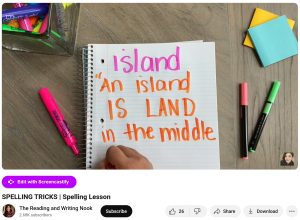8 Spelling – Strategies for Tricky Words
Category: Spelling
Concept: Spelling Strategies for Tricky Words
Connections to The Ontario Curriculum, Grades 1-8: Language (2023):
—–B2 Language Foundations for Reading and Writing
———-B2.1 Word Level Reading and Spelling
Prior Knowledge:
- Sounding out words that are phonetically regular
- Reading words by syllables
- Awareness of basic spelling patterns such as word families
What’s the definition?
Although many words in English conform to predictable spelling patterns that are based on sound-symbol correspondences or structural rules for adding endings, there are, nevertheless, many English words that have elements that provide spelling challenges. These features sometimes are due to the influence of other languages and cultures over the course of English history.
What does it look/sound like?
Spelling challenges may occur when words are not clearly pronounced in everyday speech, contain silent letters or unusual vowel or consonant combinations.
The list below represents samples of words with misleading pronunciations.
Why does it matter?
Students who have come to rely on sounding words out for spelling may struggle when faced with seemingly random spelling patterns. It is important to acquire strategies for recalling unusual features of words and to apply them in everyday writing tasks. Otherwise, students may restrict themselves to using simple vocabulary in their writing rather than struggle with more complex or challenging words. Even with the use of spell checks, having a basic spelling vocabulary is important for writing fluency.
How do I teach this?
Spelling strategies are best taught as they occur in student writing or in everyday classroom subjects. The class can brainstorm approaches to remembering tricky parts of words and develop individualized strategies that appeal to learner preferences. Students can maintain their personalized spelling lists and the classroom can display charts of words and spelling strategies for frequent reference.
Below is a series of spelling strategies that can become part of each student’s toolkit for approaching words that cannot be spelled simply by sounding them out:
Auditory Approaches:
In addition to saying words carefully and listening for each sound, students may:
Exaggerate the tricky sounds
- For example, emphasize the sound /r/ in library, /ru/ in February, invent the sound /nes/ in Wednesday, or sound the silent b in subtle
Say the word in syllables
- For example, listen to each sound as you say par – tic – u- lar – ly
Think of a linguistically related word where a silent letter or schwa vowel is sounded
- For example, when spelling bomb, think of bombard, where the silent b is sounded
- Other related pairs: column/ columnist; condemn/ condemnation; resign/ resignation; sign/ signal; muscle/muscular
- When spelling the schwa vowel o in composition, refer to the base word where the o is clearly sounded (compose). Similar pairs include define/definition; oppose/opposition; admire/ admiration
Visual Approaches:
In addition to looking at the correct spelling of a word and practising using it in a variety of contexts, you may have students:
- Highlight the parts of a word to recall by using a different font, size, or colour.
- Cluster words with similar spelling challenges into word families:

Cloze strategy:
When helping students proofread their work, replicate the parts of the word spelled correctly and leave spaces for the missed spellings.
- For example: If a student writes We bilt a campsite in the mountins. The seenery was gorgus, then help the student correct their work by creating a cloze passage for feedback that could look like the following:

Memory Tricks:
Memory tricks, or mnemonics, can be an enjoyable and effective way to recall features of words that otherwise seem hard to spell.
- For example, ie in piece, think of a piece of pie.
- To remember two s’s in dessert, think of “I like seconds for dessert” or “I like strawberry shortcake for dessert”
Using the visuals in the same images from above, what mnemonics can you come up with to help remember how to spell the word correctly? You can hover on the image for a suggestion.
Other Resources
This YouTube video (1:21 min) demonstrates the use of mnemonics for spelling tricky words.

https://youtu.be/6oOU1XhxEQM?si=thZrXtx2EuOd_QEY
The Screwed-up History of English Spelling (8:05 min) is an interesting video explaining the origin of some of the seemingly irregular spelling features of English.
https://youtu.be/zdRY0x2x6PQ?si=BswOk5aHVVV9HEiW
This book traces the history of several failed attempts to simplify the English spelling system:
Henry, Gabe (2025). Enough is Enuf: Our Failed Attempts to Make English Easier to Spell.

